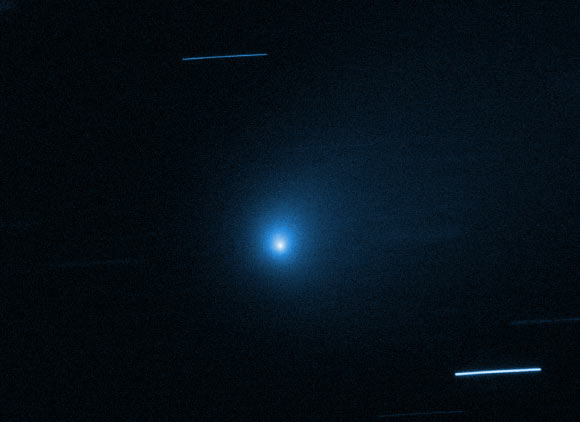NASA’s Neil Gehrels Swift Observatory Tracks Water Loss from Interstellar Comet 2I/Borisov | Astronomy – Sci-News.com
Astronomers using NASA’s Neil Gehrels Swift Observatory have tracked water loss from 2I/Borisov, the first known interstellar comet to visit our Solar System, as it approached and rounded the Sun. Their findings were published in the Astrophysical Journal Letters.

Hubble captured this image of the interstellar comet 2I/Borisov on December 9, 2019. Image credit: NASA / ESA / Hubble / K. Meech, University of Hawaii / D. Jewitt, University of California, Los Angeles.
2I/Borisov was detected on August 30, 2019 by Gennady Borisov, an astronomer at the Crimean Astrophysical Observatory in Nauchnij, Ukraine, and shown to be on a hyperbolic orbit, consistent with an interstellar origin, in the direction of Cassiopeia.
Astronomers immediately jumped into action, mobilizing powerful ground-based telescopes to measure the object’s orbit, color and other characteristics.
2I/Borisov is the second interstellar object discovered in the Solar System, and it showed comet-like activity since it was discovered, indicating sublimating ices.
In October 2019, Dr. Adam McKay of NASA’s Goddard Space Flight Center and American University and colleagues detected the first hint of water from the comet.
“2I/Borisov doesn’t fit neatly into any class of solar system comets, but it also doesn’t stand out exceptionally from them,” said Zexi Xing, a graduate student in the Department of Physics and Laboratory for Space Research at the University of Hong Kong and the Physics Department at Auburn University.
“There are known comets that share at least one of its properties.”
In the new study, Xing and colleagues confirmed the presence of water from 2I/Borisov and measured its fluctuations using ultraviolet (UV) light.
When sunlight breaks apart water molecules, one of the fragments is hydroxyl, a molecule composed of one oxygen and one hydrogen atom.
Swift detects the fingerprint of UV light emitted by hydroxyl using its Ultraviolet/Optical Telescope (UVOT).
Between September 2019 and February 2020, Xing and co-authors made six observations of 2I/Borisov with Swift.
They saw a 50% increase in the amount of hydroxyl the comet produced between November 1 and December 1, which was just seven days from the comet’s closest brush with the Sun.
At peak activity, 2I/Borisov shed 30 liters of water per second, enough to fill a bathtub in about 10 seconds.
During its trip through the Solar System, the comet lost nearly 230 million liters of water.
As it moved away from the Sun, its water loss dropped off — and did so more rapidly than any previously observed comet.
“This could have been caused by a variety of factors, including surface erosion, rotational change and even fragmentation,” Xing said.
“In fact, data from Hubble and other observatories show that chunks of the comet broke off in March.”
“We’re really happy that Swift’s rapid response time and UV capabilities captured these water production rates,” said Dr. Dennis Bodewits, a researcher in the Physics Department at Auburn University.
“For comets, we express the amount of other detected molecules as a ratio to the amount of water. It provides a very important context for other observations.”
The water production measurements helped the team calculate that 2I/Borisov’s minimum size is 0.74 km (2,428 feet) across.
The scientists estimate at least 55% of 2I/Borisov’s surface was actively shedding material when it was closest to the Sun. That’s at least 10 times the active area on most observed solar system comets.
2I/Borisov also differs from solar system comets in other aspects. For example, two teams of astronomers found that the gas coming out of the comet contains unusually high amounts of carbon monoxide.
The comet does have some traits in common with solar system comets, though. Its rise in water production as it approached the Sun was similar to previously observed objects.
Xing and co-authors also found that other molecules in 2I/Borisov’s chemical inventory and their abundances are similar to solar system comets.
For example, with respect to hydroxyl and cyanogen 2I/Borisov produced a small amount of diatomic carbon, a molecule made of two carbon atoms, and amidogen, a molecule derived from ammonia. About 25% to 30% of all solar system comets share that trait.
But 2I/Borisov’s combined characteristics defy placement in any single known comet family. Scientists are still pondering what this means for comet development in other planetary systems.
_____
Zexi Xing et al. 2020. Water Production Rates and Activity of Interstellar Comet 2I/Borisov. ApJL 893, L48; doi: 10.3847/2041-8213/ab86be
This article is based on text provided by the National Aeronautics and Space Administration.





